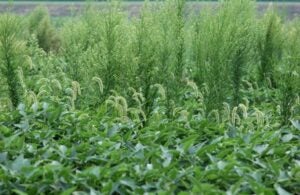It has been a quarter century since corn and soybeans were engineered to withstand the withering mists of the herbicide glyphosate. Initially heralded as a “silver bullet” for weed control, the modified crops and their herbicide companion were quickly and widely adopted across corn and soybean-growing regions of North America.
In the years that followed, though, weeds targeted for eradication quietly fomented a rebellion.
A new PNAS Nexus study led by scientists from the U.S. Department of Agriculture’s Agricultural Research Service and the University of Illinois Urbana-Champaign takes a retrospective look at glyphosate efficacy after commercializing the engineered crops.
Research has long indicated that weed control periods and full, labeled application rates are critical to controlling weed populations — partial applications kill only weaker weeds and inadvertently spur a population shift toward hardier and resistant weeds. However, this particular PNAS Nexus study explores the need to diversify weed management systems.
Amassing data from annual herbicide evaluation trials at land-grant universities across the U.S. and Canada, the researchers show a significant and rapid decline in glyphosate control for all seven major weed species they examined.

“Our analysis represents one of the largest cumulative measures of how weed communities have adapted to the simplified weed management tactics adopted at an unprecedented scale throughout North America,” said Chris Landau, postdoctoral researcher for USDA-ARS and first author on the paper.
“Nature did exactly what we were trying to help people avoid: It adapted,” said co-author Aaron Hager, professor and faculty Extension specialist in the Department of Crop Sciences and Illinois Extension.
Although glyphosate provided superior weed control in the early years, most of the weeds in the dataset showed signs of adaptation to the chemical in just two to three years. Within a decade, weeds were up to 31.6 percent less responsive to glyphosate, with further linear declines as time went on.
In addition to loss of control, glyphosate efficacy became more variable over time.
“When glyphosate-tolerant crops were first adopted, weed control was high in every environment; however, year after year, glyphosate performance became less consistent,” said co-author Marty Williams, an ecologist with the USDA-ARS and affiliate professor of crop sciences.
The patterns were derived from annual herbicide evaluation trials conducted at land-grant universities.
For the current study, Landau winnowed the data down to fields that tested glyphosate annually, alone or in combination with a pre-emergence herbicide. He also narrowed the target weeds to seven major players: Annual and giant ragweed, horseweed, lambsquarter, Palmer amaranth, velvetleaf, and waterhemp. In the end, the dataset represented trial data from 11 institutions.
After documenting patterns of glyphosate control and variability over time, Landau re-ran the analysis for plots in which a pre-emergence herbicide had been applied before glyphosate. The results were strikingly different.
“Adding a pre-emergence herbicide effective against the target weed species significantly improved control and reduced variability of glyphosate over time,” Landau said. “The most we saw for any weed species was a 4.4 percent loss of control per decade, compared to 31.6 percent loss for glyphosate alone.”
Landau noted that two species he tracked in the analysis, velvetleaf, and lambsquarter, have not yet had a confirmed case of glyphosate resistance anywhere in the world. Yet both followed the same trends as glyphosate-resistant species in the dataset. He said herbicide pressure, or concurrent climate changes, over the past 25 years may have been selected for larger leaf areas or earlier emergence, which could help weeds survive glyphosate.
The researchers urge diversification in chemistries, including soil- and foliar-applied products, crop rotation patterns, and mechanical controls.
»Related: Using full, labeled corn herbicide rates is the strategy that works


